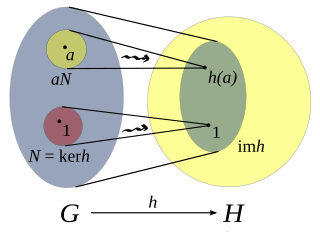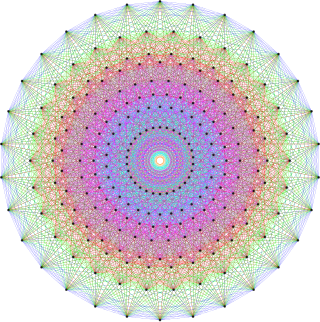
In mathematics, given two groups, (G,∗) and (H, ·), a group homomorphism from (G,∗) to (H, ·) is a function h : G → H such that for all u and v in G it holds that
In mathematics, especially in category theory and homotopy theory, a groupoid generalises the notion of group in several equivalent ways. A groupoid can be seen as a:
In algebra, a homomorphism is a structure-preserving map between two algebraic structures of the same type. The word homomorphism comes from the Ancient Greek language: ὁμός meaning "same" and μορφή meaning "form" or "shape". However, the word was apparently introduced to mathematics due to a (mis)translation of German ähnlich meaning "similar" to ὁμός meaning "same". The term "homomorphism" appeared as early as 1892, when it was attributed to the German mathematician Felix Klein (1849–1925).
In mathematics, the Yoneda lemma is a fundamental result in category theory. It is an abstract result on functors of the type morphisms into a fixed object. It is a vast generalisation of Cayley's theorem from group theory. It allows the embedding of any locally small category into a category of functors defined on that category. It also clarifies how the embedded category, of representable functors and their natural transformations, relates to the other objects in the larger functor category. It is an important tool that underlies several modern developments in algebraic geometry and representation theory. It is named after Nobuo Yoneda.
In category theory, a branch of mathematics, a natural transformation provides a way of transforming one functor into another while respecting the internal structure of the categories involved. Hence, a natural transformation can be considered to be a "morphism of functors". Informally, the notion of a natural transformation states that a particular map between functors can be done consistently over an entire category.
In mathematics, specifically abstract algebra, the isomorphism theorems are theorems that describe the relationship among quotients, homomorphisms, and subobjects. Versions of the theorems exist for groups, rings, vector spaces, modules, Lie algebras, and other algebraic structures. In universal algebra, the isomorphism theorems can be generalized to the context of algebras and congruences.

In mathematics, equality is a relationship between two quantities or expressions, stating that they have the same value, or represent the same mathematical object. Equality between A and B is written A = B, and pronounced "A equals B". In this equality, A and B are distinguished by calling them left-hand side (LHS), and right-hand side (RHS). Two objects that are not equal are said to be distinct.
In mathematics, particularly linear algebra, an orthonormal basis for an inner product space with finite dimension is a basis for whose vectors are orthonormal, that is, they are all unit vectors and orthogonal to each other. For example, the standard basis for a Euclidean space is an orthonormal basis, where the relevant inner product is the dot product of vectors. The image of the standard basis under a rotation or reflection is also orthonormal, and every orthonormal basis for arises in this fashion. An orthonormal basis can be derived from an orthogonal basis via normalization. The choice of an origin and an orthonormal basis forms a coordinate frame known as an orthonormal frame.
In algebra, a module homomorphism is a function between modules that preserves the module structures. Explicitly, if M and N are left modules over a ring R, then a function is called an R-module homomorphism or an R-linear map if for any x, y in M and r in R,
In algebra, a field k is perfect if any one of the following equivalent conditions holds:
In mathematics, a sesquilinear form is a generalization of a bilinear form that, in turn, is a generalization of the concept of the dot product of Euclidean space. A bilinear form is linear in each of its arguments, but a sesquilinear form allows one of the arguments to be "twisted" in a semilinear manner, thus the name; which originates from the Latin numerical prefix sesqui- meaning "one and a half". The basic concept of the dot product – producing a scalar from a pair of vectors – can be generalized by allowing a broader range of scalar values and, perhaps simultaneously, by widening the definition of a vector.
In mathematics, the derived categoryD(A) of an abelian category A is a construction of homological algebra introduced to refine and in a certain sense to simplify the theory of derived functors defined on A. The construction proceeds on the basis that the objects of D(A) should be chain complexes in A, with two such chain complexes considered isomorphic when there is a chain map that induces an isomorphism on the level of homology of the chain complexes. Derived functors can then be defined for chain complexes, refining the concept of hypercohomology. The definitions lead to a significant simplification of formulas otherwise described (not completely faithfully) by complicated spectral sequences.
In commutative algebra and field theory, the Frobenius endomorphism is a special endomorphism of commutative rings with prime characteristic p, an important class that includes finite fields. The endomorphism maps every element to its p-th power. In certain contexts it is an automorphism, but this is not true in general.
In functional analysis, a branch of mathematics, an abelian von Neumann algebra is a von Neumann algebra of operators on a Hilbert space in which all elements commute.
In mathematics, specifically abstract algebra, the opposite of a ring is another ring with the same elements and addition operation, but with the multiplication performed in the reverse order. More explicitly, the opposite of a ring (R, +, ⋅) is the ring (R, +, ∗) whose multiplication ∗ is defined by a ∗ b = b⋅a for all a, b in R. The opposite ring can be used to define multimodules, a generalization of bimodules. They also help clarify the relationship between left and right modules (see § Properties).
In universal algebra and in model theory, a structure consists of a set along with a collection of finitary operations and relations that are defined on it.
In category theory, a regular category is a category with finite limits and coequalizers of all pairs of morphisms called kernel pairs, satisfying certain exactness conditions. In that way, regular categories recapture many properties of abelian categories, like the existence of images, without requiring additivity. At the same time, regular categories provide a foundation for the study of a fragment of first-order logic, known as regular logic.
In algebraic geometry, a morphism between algebraic varieties is a function between the varieties that is given locally by polynomials. It is also called a regular map. A morphism from an algebraic variety to the affine line is also called a regular function. A regular map whose inverse is also regular is called biregular, and the biregular maps are the isomorphisms of algebraic varieties. Because regular and biregular are very restrictive conditions – there are no non-constant regular functions on projective varieties – the concepts of rational and birational maps are widely used as well; they are partial functions that are defined locally by rational fractions instead of polynomials.

In mathematics, the complexification or universal complexification of a real Lie group is given by a continuous homomorphism of the group into a complex Lie group with the universal property that every continuous homomorphism of the original group into another complex Lie group extends compatibly to a complex analytic homomorphism between the complex Lie groups. The complexification, which always exists, is unique up to unique isomorphism. Its Lie algebra is a quotient of the complexification of the Lie algebra of the original group. They are isomorphic if the original group has a quotient by a discrete normal subgroup which is linear.
In mathematics, a profinite integer is an element of the ring



















